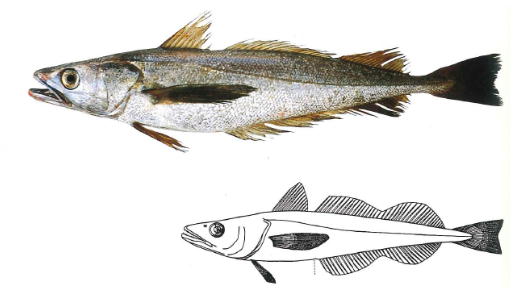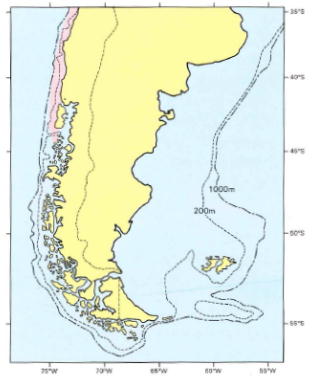メルルーサ科
- HOME
- デジタル図鑑
- パタゴニア海域の重要水族
- 硬骨魚綱 タラ目
- メルルーサ科
メルルーサ科(Merlucciidae)

External feature
35 Merluccius gayi gayi (Guichenot, 1848)
チリへイク(Chiri-heiku)
Merluza comun (Ch.); Chilean hake (English speaking countries)
特 徴:
第1背鰭1棘,9〜12軟条,第2背鰭37〜42軟条,臀鰭36〜42軟条,胸鰭15〜17軟条,腹鰭7軟条,鰓条骨数7,縦列鱗数108〜128,鰓耙数3〜6+15〜19=19〜25,脊椎骨数21〜24+27〜30=49〜53。体長に対する頭長の割合は26.0〜30.5%。体高は16.2
〜18.4 %, 胸鰭長は19.0 〜23.4 %,腹鰭長は12.3 〜15.1 %,背鰭前長は29.7 〜32.7 %, 頭長に対する吻長の割合は29.3
〜34.1 %,眼径は15.6 〜18.9 %,両眼間隔は24.3 〜28.0 %,上顎長は43.7 〜48.5 %。 体は細長く,やや側扇する。
吻端はやや縦扇する。 頭部, 眼, 口は大きい。 上顎の後端は眼の中央下に達する。 下顎は上顎より前方に突出する。 両顎歯は鋭〈大きな犬歯状歯で,
内側に のみ可倒性。 背鰭は2基,第2背鰭と磐鰭のほぽ中央に大きな欠刻がある。 胸鰭は 長し その先端は臀鰭起部に達するか,ある いはそれを越える。
尾鰭後縁は通常湾入する。 鱗はやや大きい。肋骨は ほぼ3本。 体は一様に銀白色,背方はやや暗色をおびる。
分 布:
南米のペルー,チリ沖の主に大陸棚上。 南緯4度のマンコラパンク付近から南緯40度のチロエ島付近まで, 一部はフィヨルド内に も分布する(Zama
and Cardenus, 1984),ペルー 南部からチリ北部にかけて分布域はやや中断する。 生息水深 は50 〜500m。
備 考:
本種は チリとペルー のものは亜種で区別されている。 夏に南下し,沿岸域へ来遊する。 冬から春にかけ北上し, 水深200 〜500mに回遊し,春(8 〜11月)に沖合で産卵する。 チリの亜種は4歳で41cm (雄), 46 cm (雌)に成長し,雌は42cmで成熟する。 最大体長は87cm.夜間浮上し, 主に魚類,イカ,オキアミを食べる。 本種はニュー ジーランドへイクとは鱗と 眼の大きさ,胸鰭の長さ,尾鰭の形で区別される(In ada,1981b) 。
(稲田伊史)
Material examined:
30 from Chile (160.7 490.0 mm SL), catalogue numbers: see Inada. (1981b).
Description:
D I, 9-12, 37-42; A 36-42; P1 15-17; P2 7; BR 7; ORS 108-128; GR 3- 6+15-19=19-25;
V 21-24+27-30=49 53. HL 26.0-30.5% of SL; ED 15.6-18.9; BD 16.2-18.4; SN 29.3-34.1; IO 24.3-28.0; UJ 43.7-48.5; P1 L 19.0-23.4;九L 12.3-15.1; PreD 29.7-32.7.
Body elongate, slightly compressed; snout slightly depressed. Head, eyes, mouth large; end of upper jaw reaching below midpoint of eye; lower jaw projecting further forward than 島upper; pointed and large canine like teeth on both jaws, depressible inward. Dorsal fins two; middle of second dorsal and anal fins deeply notched; pectoral fin long, its tip reaching to or extending beyond origin of anal fin; caudal margin usually concave. Scales somewhat large. Ribs usually 3. Body uniformly silvery except for darker dorsal region.
Distribution:
Mainly on the continental shelf o任Peru and Chile, South America, from the Mancora Bank, 4・S to the Chiloe Island, 40'S; some populations living in the Moraleda Channel (Zama and Cardenas, 1984). The distribution is discontinuous from southern Peru to northern Chile. Depth range is from 50 m to 500 m.
Remarks:
This species is separated into two subspecies, M. g. ρeruvianus from Peru and M. g. g,のi from Chile. Chilean hake move to southern coastal areas in summer and migrate to northern deeper waters (200-500 m depth) in winter and spring. The spawning season is in spring (August to November). The Chilean subspecies grows to 41 cm SL (male), 46 cm SL (female) by the age of 4 years, females maturing at 42 cm SL. The Maximum length recorded is 87 cm SL. This fish migrates vertically to midwater at night feeding on fishes, squids and euphausids. It di任ers from the very similar New Zealand hake, M. G附tralis by characters such as scales, eye size, pectoral fin length, and shape of caudal fin margin (Inada, 1981b).
(Tadashi INADA)

Distribution of Merluccius gayi gayi in Patagonia.